Disclaimer: Timeusb sent this product to us for free for a review. That does not affect our opinion about the product. In this article, we list both what we like and dislike. Read more about this here.
Should You Buy The Timeusb 12V 100Ah Pro Lithium Battery?
Timeusb sent out a couple of its products for us to test, and it’s time to look at their popular 12V 100Ah Pro LiFePO4 battery.
Just like a lot of lithium batteries like this, it’s rated at 100Ah at 12.8V, which results in a 1280Wh capacity.
Related Post: Timeusb LiFePO4 Battery Charger Review
While it shares specifications with some of its competitors I have reviewed, I was curious to see if this battery performed better or worse than them.
Specifications – Timeusb 12V 100Ah LiFePO4
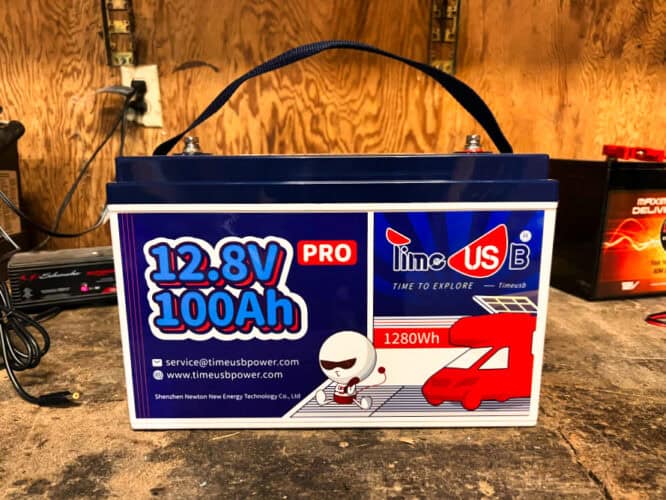
Battery Cells
Timeusb uses lithium iron phosphate (LiFePO4) cells in this and all of its other batteries.
LiFePO4 cells are better than the more common lithium-ion, offering a more safe and durable chemistry.
You can easily test the voltage of the battery with a multimeter.
The working temperature range of this battery is the following
- Charge: 0°C-50°C
- Discharge: -20°C-60°C
Because of the temperature limitations, you need to be more careful than with the older lead-acid type batteries.
Charging this battery in freezing temperatures can cause permanent damage to the cells and eventually destroy the battery completely.
If you regularly camp in below-freezing temperatures, look at a self-heated LiFePO4 battery instead.
Ratings – Ampere hours (amp hours) and watt-hours
The battery is rated at 100Ah, which is 1280 watt-hours at 12.8V
The max continuous charge and discharge current is 100Ah, so you can technically pull the full 1280W and drain the battery within an hour.
One thing to note about that is that even though it’s a 100Ah battery and the max discharge current is 100Ah, does not mean that it will last exactly an hour when doing so.
The operating voltage of the battery is 12.8V, and the charging voltage 14.4V.
The SOC (state of charge) can be can be roughly estimated by the resting voltage, the numbers below are from the manual.
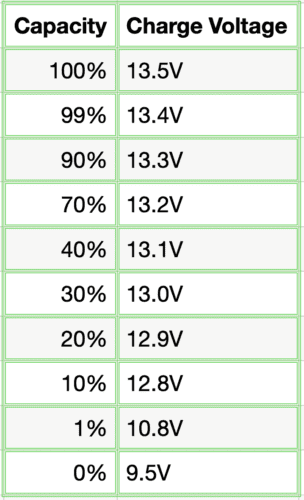
Safe features with built-in BMS
BMS stands for battery monitoring system. It’s there to protect and prevent overcharging, over-discharging, overcurrent, and short circuits.
Cycle life
The battery is rated for 4000+ cycles to 80%.
If the DoD (depth of discharge) is 80%, it’s rated at 6000 cycles, and 15000 cycles at 60% DoD.
Expandability
You can combine two or more Timeusb batteries in either series or parallel.
According to the manual, it supports up to four batteries in series or parallel. But up to 8 batteries in a series-parallel configuration.
The included manual explains how to go about doing this.
When configuring two or more batteries together, it’s recommended to use the same type of batteries with the same ratings. They should also be similarly aged.
Design and what’s included
The design of this battery is nothing out of the ordinary.
It has a strap on top that makes it easy to carry the battery, other than that there are the two terminals on top where you’re going to connect your battery wires.
The only thing included in the box other than the battery itself is two terminal screws.
Related: Timeusb 12V/24V Battery DC USB Hub Full Review & Test
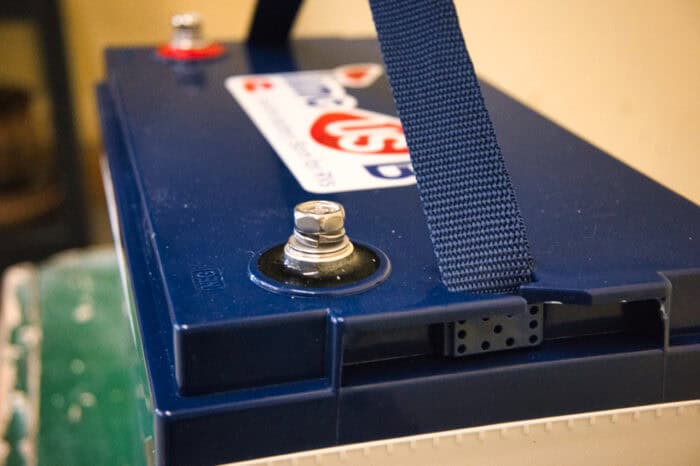
Size and Weight
The battery weighs 24.2 lbs and measures 13 x 6.82 x 8.48 inches.
Review And Test Results
Like
Large capacity for the money
It’s a very affordable 100Ah 12V LiFePO4 battery, and it’s incredible how much these have fallen in prices just this past year.
In my opinion, the initial cost of lithium is very worth it. Even if it’s a battery that will not be used daily, it’s going to last a long time as long as you take care of it.
One thing that impressed me is the fact that I could pull almost 1900W without a problem.
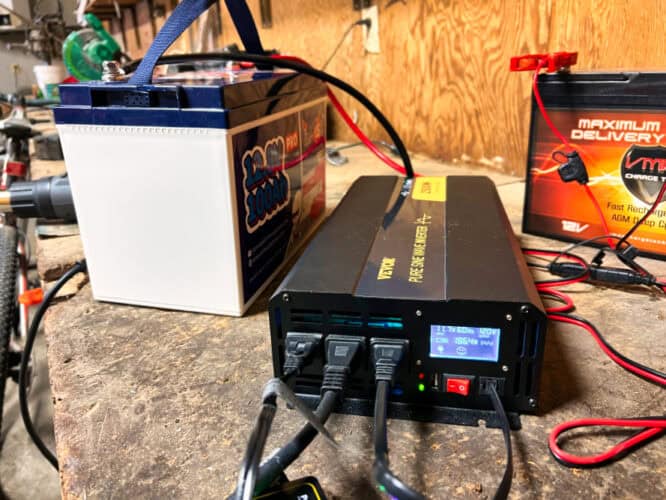
I don’t recommend doing this, because it exceeds the 100Ah current limit, but it worked for at least the five minutes I tested it.
Some of the similar batteries I have reviewed have had a hard 100Ah limit, which has shut down the output if it was exceeded by even one Ah.
Is this a good or a bad thing? Well, it’s going to cause more stress on the battery.
I still view it as a good thing since it makes it possible to power electronics that require around 1500W as long as you have an inverter that can output more than that.
The capacity test ended at 105Ah, which is excellent for 100Ah battery. It’s great that these batteries are larger than specified, instead of smaller.
I did not have a way to test the 100Ah charging limit. I charged the battery with the Timeusb 20A battery charger and the BougeRV MPPT solar charge controller.
Very light compared to lead-acid batteries.
Compared to my AGM battery, the Timeusb 12V 100Ah is very light.
If you’re an Rver with a lead-acid house battery, replacing it with this is going to save you a lot on weight.
Imagine if you’re replacing two or building a battery bank with four batteries. The weight adds up.
LiFePO4
LiFePO4 batteries are great not only because they’re lithium, but because they’re one of the best kinds of lithium.
It’s not the lithium-ion that can be unreliable and combust if overheated.
I applaud Timeusb for using LiFePO4 batteries in all of its products.
Don’t Like
No built-in heating
The downside to lithium is that they don’t like freezing temperatures.
They can handle being discharged in freezing temperatures (at least to 0°F/20°C). But charging is a big no-no, unless it has built-in self-heating.
What I don’t like with the Timeusb battery specifically, related to this, is that the BMS doesn’t have a low-voltage cutoff.
So it will still let you charge and discharge in temperatures that can have detrimental effects on the cells.
Conclusion
I recommend the Timeusb 12V 100Ah Pro LiFePO4 battery. It passed every test I did, and it didn’t even get warm during any of them.
As long as you’re aware of the downsides with a lithium battery that does not self-heat, or prevents a charge below freezing temperatures, I believe you are going to be satisfied with this purchase.
One thing I want to mention is that Timeusb responded swiftly to my emails and questions. I can’t say that about every battery manufacturer and seller.
That’s a big plus in my book, and I hope they treat customers the same.
Frequently Asked Questions
Is it a drop-in replacement for my RV battery?
It might be, if the converter charger in your RV supports lithium.
I suggest reading the owner’s manual to find out what type of batteries the converter charger in your specific RV/camper supports.
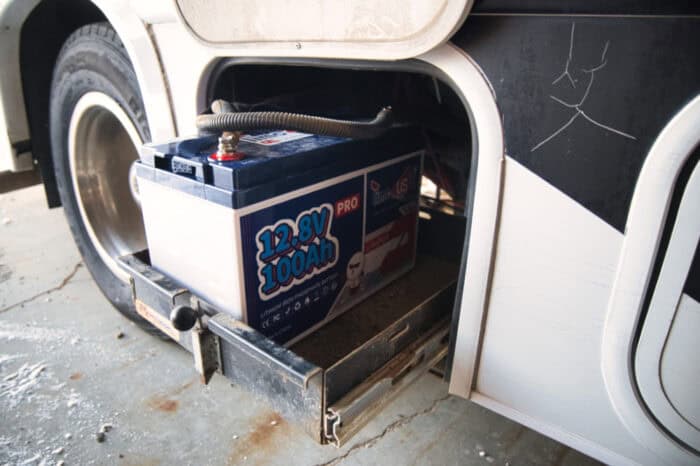
You also need to know how to wire the battery to your RV properly.
If you’re using 6V batteries today, they’re most likely wired in series before they’re connected to your RV.
With two 12V batteries, you need to connect them in parallel for a 12V system.
Which inverter do you recommend?
An inverter changes the DC battery power to AC current and makes it possible to power regular household 120V devices off of the battery.
I recommend at least a 1500W inverter, since the battery is rated for up to 1280W. Lookup the power requirements for the device you want to power to figure out whether the battery or the inverter is going to be powerful enough.
My tests were done using the Vevor 2500W pure sine wave inverter.
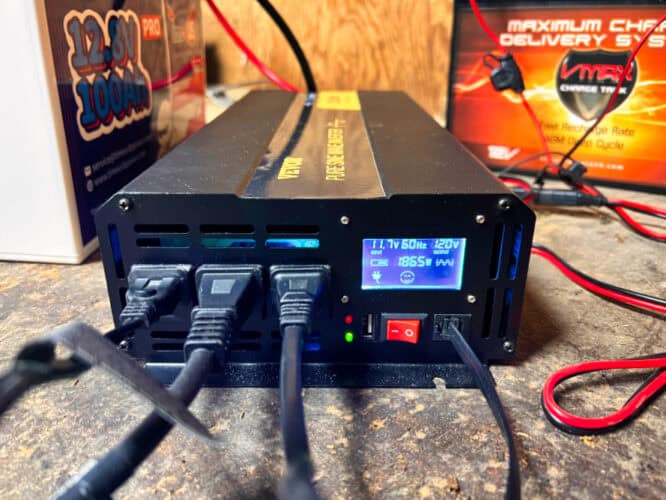
If you would like to double the maximum continuous output current, you can configure two batteries together in parallel.
By doing this, the amperages will add up, but the voltage will stay the same.
Please leave a comment if you have questions.

